Archived Blog Posts
Where to start restoration after a fire in your commercial property.
1/29/2022 (Permalink)
 Fire cleanup should start as soon as it's safe to re-enter your building
Fire cleanup should start as soon as it's safe to re-enter your building
A fire affects your business in many ways, bringing your daily operations to a halt and causing financial losses due to damage and sometimes even theft or vandalism at your commercial property.
The right information and preparation can help you take the correct steps to minimize those problems. Fire cleanup should start as soon as it's safe to re-enter your building.
What To Expect
There may be serious damages in your building that extend beyond the reach of the flames. You should watch for the following issues:
- Water and chemicals may have deteriorated equipment and furnishings.
- Firefighters may have cut holes in the walls and ceiling to find hidden flames.
- Smoke damage could have stained paint and seeped into the walls, ceilings, and floors.
How Repairs Begin
In many instances of after a fire damage, roof repair is the first step in securing your business and preventing further damages as apart of the restoration procedure. This is because the roof has often been harmed by the blaze itself, the water used to put out the flames, and the holes made by firefighters. Why would professionals cut into the roof? As flares burn, they move quickly up, across and down. Firefighters create openings in the roof to provide ventilation, getting rid of the thick black smoke that makes it hard to see. This slows the progress of the fire and ultimately increases the respondents’ ability to save your property from complete ruin.
When fire remediation professionals arrive, they may begin with tarp services to protect the rest of your building and possessions from further damages. Putting a tarp on the roof to cover holes can keep rain, debris, and pests out of your building.
Who To Contact
Much of the work to repair and restore your property can be handled by fire remediation professionals. Fire cleanup services generally include restoration from flames, smoke, water, and chemicals. Roof repairs are often some of the first steps professionals take. Your prompt decision to involve these experts may reduce the extent of damages.
3 Ways To Maintain Your Business's Roof
1/22/2022 (Permalink)
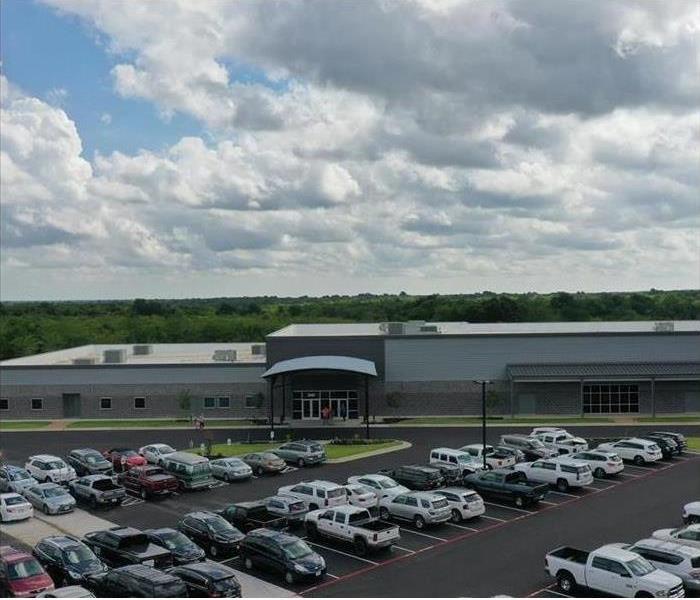 A roof leak or collapse can be devastating to a business
A roof leak or collapse can be devastating to a business
3 Ways To Maintain Your Business's Roof
A roof leak or collapse can be devastating to a business, causing flooding and ruining merchandise. Roof damage, in fact, is a difficult situation, making reopening your store a hassle and expense. Avoiding this disaster isn't impossible, but steps can be taken to minimize the chances.
- Attend to Small Problems Quickly
Don't assume your structure is intact simply because you can't see water stains. Wind damage and harsh rain can wear it down, causing tiny complications. Contact roofing specialists to conduct biannual evaluations, looking for any of the following issues:
- Peeled edges
- Cracked roofing
- Missing shingles
- Flashing issues
Leaving any of these unattended exposes the building to leaks and water damage. Fix things as soon as they come to your attention.
- Tend To Drainage and Debris Early
Are gutters clear? If they become clogged, backups happen, allowing water to build in areas it shouldn't. This pressure could add unneeded pressure to the top, essentially weighing it down. That collapse is not pretty. Have property management look at the gutter system regularly, scheduling clean outs. Trees and brush become an additional hazard. Roof damage often happens when limbs and branches are picked up during storms and then thrown into the roofing. Those smacks punch holes and remove the protective shingles. To avoid this, have someone trim the foliage and, before a major weather event, pick up anything loose on the ground. - Apply To Insurance Immediately
If you need help restoring the premises, contact a water restoration company to inspect the establishment, looking for mold and flooding complications. Their recommendation may indicate a roof rebuild is needed. Don't underestimate that decision. Work with your insurance company to discuss the need, giving you the comfort of a secure new ceiling. In fact, ask about waterproofing for the future. This sealant might aid in keeping leaks from sprouting up in the future.
Roof damage has preventative measures. By looking at it periodically, management might find the weak areas, offering a chance to stop a major catastrophe. In addition, don't forget that taking care of the landscaping may also ward off potential troubles.
Six Common Causes for Water Loss
1/15/2022 (Permalink)
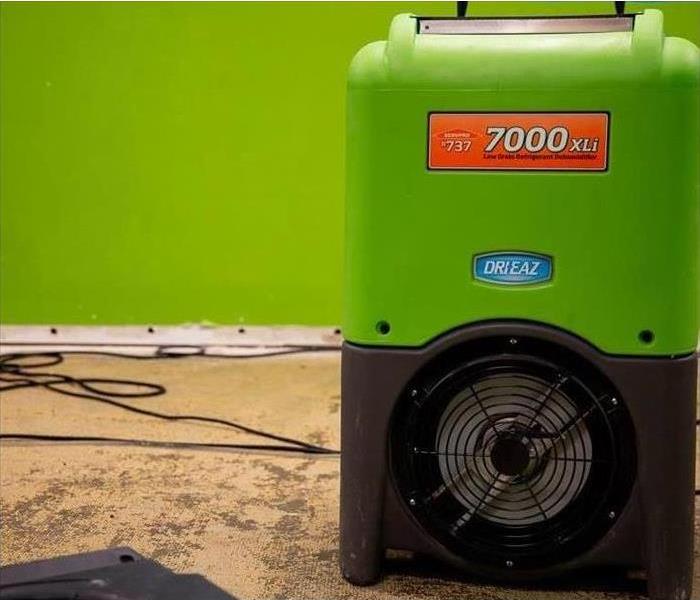 Water Damage Restoration
Water Damage Restoration
While even clean water can be damaging and require the need for water damage restoration services, it’s reassuring to know that unwanted water in your building is not contaminated or unsafe to handle.
Here are six common causes of water loss, that are considered Category 1 water.
Broken Supply Line
Supply lines can start to leak around fittings and connections, or a sharp object can cause a supply line: broken pipe to break completely and start to gush out. Deterioration, freezing temperatures, and earthquakes can also can a water line to break.
Cracked or Broken Pipe
Broken pipes are a common cause of water damage. While an undetected leak that has been sitting for a long period time is likely contaminated, a recent pipe burst is a clean water source.
Overflowing Sink or Tub
If a sink or tub is accidentally left leaking or a drain is plugged, water can overflow and cause extensive damage. As long as there were no contaminants in the sink or tub, this water is considered Category 1.
Clean Toilet Bowls
An overflowing toilet with no urine or feces in it is still considered clean water. If only urine is present, the water is labeled Category 2. Water with feces is grossly contaminated Category 3 water.
Melted Ice or Snow and Rainwater.
As long as it hasn’t come into contact with contaminants, water from melted ice or snow is safe to handle. Additionally, rainwater is considered clean enough to touch and even consume.
Appliance Malfunction
While water that leaks from a dishwasher or washing machine may be slightly contaminated, other appliance leaks are considered safe. However, you will need to be careful to avoid electrical hazards.
A positive sign that floodwater in your building is Category 1 is that it came from a clean water source. While there are other potential causes of flooding or leaks, these water sources are some of the most common.
Cleaning up After Water Damage in Your Home
1/8/2022 (Permalink)
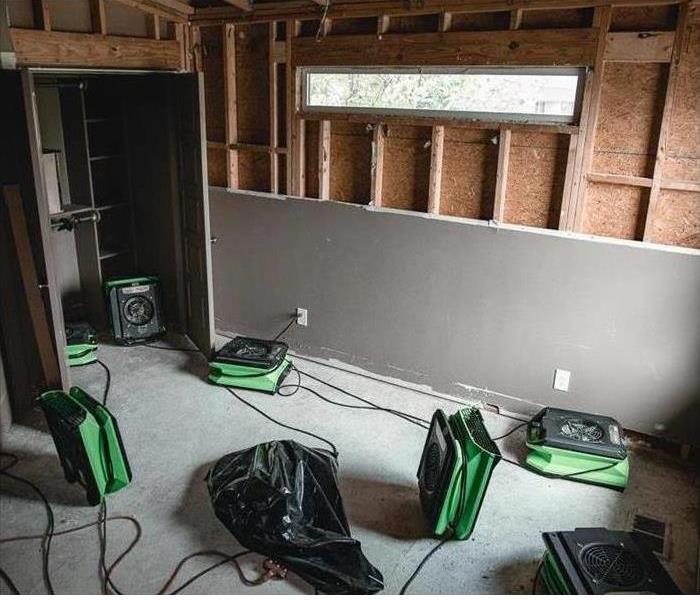 When you get the right help many items are salvageable when there is water in your home!
When you get the right help many items are salvageable when there is water in your home!
No homeowner wants to experience the dread of finding flooding in the house. Even minor water damage can be costly and difficult to clean up.
After your safety and that of your family members, you worry about your belongings and materials. Fortunately, when you get the right help on your side, many items are salvageable when there is water in your home.
What You Can't Clean
In most cases, when water saturates porous material, you must throw it out. Failure to do this could result in mold growth. Some typical items you'll want to tear out and replace include:
- Drywall
- Carpet
- Ceiling tiles
Documents
If a broken pipe or other problems bring water into your , home, items such as books, photographs, maps and other paper are at risk. You should first remove the materials from harm's way. Put them in a place where they can dry out. To completely clean them, a professional crew will use specialized techniques to remove the water preserve the documents. Freeze-drying is one of the most common tactics.
Furniture
In a flood, furniture is susceptible to damage. Flood cleanup specialists can address water issues on couches, chairs and other items and allow you to keep them intact. The crew will use dry cleaning to thoroughly extract and dry the furniture. The team will also disinfect the furniture to discourage mold growth.
Electronics
it's vital with water in home that you don't turn on any electronic devices. Instead, unplug the products and get them away from any water. A professional company has the skills and tools to clean your electronics. The technicians will handle your belongings with care and respect. The team will start by using damp cloths to remove dust and then will clean the interior of the electronics.
It's never good to see water in home, but you can clean most items. Get a flood cleanup team on the job, and your possessions can look as good as new.
Water Damages rarely wait for when it's convenient. When is the most inconvenient? Vacation.
1/1/2022 (Permalink)
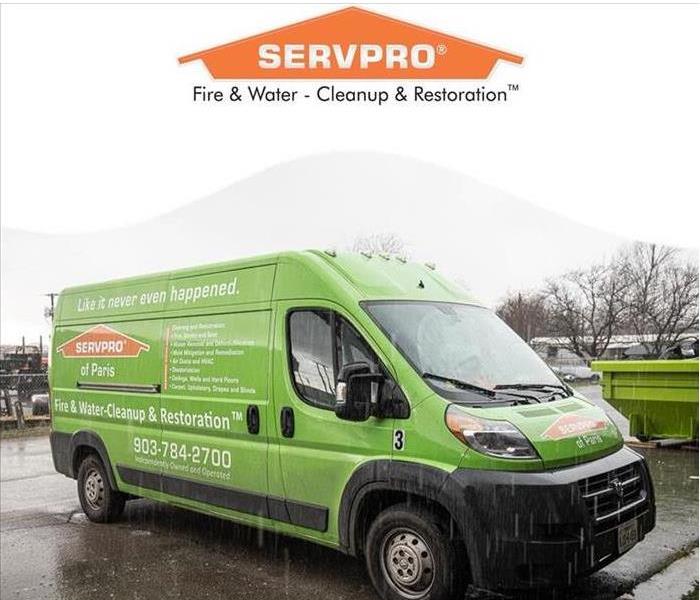 SERVPRO OF DURANT HELPING TO MAKE WATER DAMAGE “Like it never even happened.”
SERVPRO OF DURANT HELPING TO MAKE WATER DAMAGE “Like it never even happened.”
The last thing that should be on your mind when you’re on vacation is whether a broken pipe or water heater bust has flooded your home. This can cause damage to your belongings and your home, so the best thing is prevention.
Prevent Damage
One of the main causes of water damages is the water heater. It’s a good idea to shut it off. If a pipe breaks or the valve gives, hot water will flood the home, and water will continue to fill the tank and leak out of whatever gave way. Other appliances generally won’t leak unless in use.
If leaving the home during winter, turn the heat down but not so low that pipes can freeze. Keep the water running at a drip to prevent freezing.
Wrap the pipes. Exposed pipes can always use the extra insulation from the elements.
Keep an Eye on Your Home
If you’re going to be gone for several days, it’s not a bad idea to have a neighbor, family member or friend stop by the house once in a while. This can be just a quick peek inside to verify there is no flooding, a broken pipe, or any other issues.
You can also use web cameras that can be viewed from a phone or computer to check on your home. This won’t prevent a pipe from bursting, or a flood but it can allow you to at least get a professional there sooner and prevent further water damage.
A higher standard of clean
12/25/2021 (Permalink)
 Call us today to schedule your cleaning!
Call us today to schedule your cleaning!
Certified: SERVPRO Cleaned is a defensive cleaning program that goes beyond janitorial or carpet cleaning.
This is proactive viral pathogen cleaning that helps ensure the cleanliness of the restaurants, businesses and public spaces in the communities we all call home. With over 50 years of expertise, SERVPRO professionals are trained and experienced in biohazard decontamination and chemical spills - always adhering to the cleaning and decontamination standards set by the Centers for Disease Control and Prevention and local authorities.
- Are you interested in a free quote for our Commercial Services, or are you a Consumer who wants to learn more about the program?
We would love the opportunity to schedule a brief call with you to discuss employee safety, business continuity, and our pricing.
Call us today to schedule your cleaning.
(580) 740-4848
Thanks to our Commercial Large Loss Division ... NO JOB IS TOO LARGE!
12/18/2021 (Permalink)
 "Like it never even happened."
"Like it never even happened."
The SERVPRO Commercial Large Loss Division is composed of our best of the best in restoration.
Our elite large-loss specialists are pre-qualified and strategically positioned throughout the United States to handle any size disaster.
Every large loss is supervised by a commercial operations manager to help ensure seamless communication and timely mitigation. The rate at which things move with ease and precision is unparalleled.
The SERVPRO Advantage is our ability to dispatch trained production professionals and cut costs through the strategic placement and oversight of temporary labor. Our team is massive and can be readied quickly to save you time!
Clients for the Commercial Large Loss program include the following:
- The Hospitality Industry
- Property Managers
- Universities
- Municipalities
HELPING TO MAKE FIRE AND WATER DAMAGE “Like it never even happened.”
Air Ducts, When Was Yours Cleaned?
12/11/2021 (Permalink)
 SERVPRO of Durant professionals routinely inspects the heating, ventilation and air conditioning unit (HVAC)
SERVPRO of Durant professionals routinely inspects the heating, ventilation and air conditioning unit (HVAC)
According to the EPA:
You should consider having the air ducts in your home cleaned if-
- There is substantial visible mold growth inside hard surface ducts or on other components of your heating and cooling system.
- There is an odd smell coming from the Duct system.
- Ducts are infested with vermin, e.g. (rodents or insects)
- Ducts are clogged with excessive amounts of dust and debris and/or particles are actually released into the home from your supply registers.
Some research also suggests that cleaning dirty cooling coils, fans and heat exchangers can improve the efficiency of heating and cooling systems.
Is cleaning my air ducts really that important?
During normal operation, dust can accumulate in ductwork that can lead to microbial growth. Duct cleaning has been shown to reduce this growth, as well as increase the efficiency of your system. In fact, in some cases of extreme buildup, it can increase efficiency as much as 40 percent!
SERVPRO of Durant professionals routinely inspects the heating, ventilation and air conditioning unit (HVAC). Keeping them clean can extend the life of the equipment. This can, in turn, save you money and give you cleaner air to breathe.
For more information on HVAC and air duct cleaning or a free quote call us today! (580) 740-4848
Smoke and Soot Cleanup
12/4/2021 (Permalink)
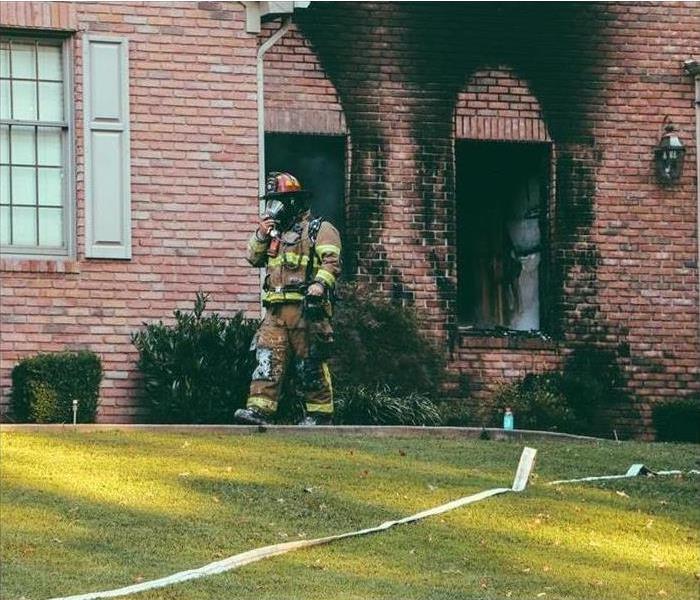 SERVPRO of Durant has the equipment, expertise, and experience to restore your fire and smoke damage.
SERVPRO of Durant has the equipment, expertise, and experience to restore your fire and smoke damage.
Smoke and soot is very invasive and can penetrate various cavities within your home, causing hidden damage and odor.
Our smoke damage expertise and experience allows us to inspect and accurately assess the extent of the damage to develop a comprehensive plan of action.
Smoke and soot facts:
Hot smoke migrates to cooler areas and upper levels of a structure.
Smoke flows around plumbing systems, seeping through the holes used by pipes to go from floor to floor.
The type of smoke may greatly affect the restoration process.
Different Types of Smoke
There are two different types of smoke–wet and dry. As a result, there are different types of soot residue after a fire. Before restoration begins, SERVPRO of Durant will test the soot to determine which type of smoke damage occurred. The cleaning procedures will then be based on the information identified during pretesting. Here is some additional information:
Wet Smoke – Plastic and Rubber
Low heat, smoldering, pungent odor, sticky, smeary. Smoke webs are more difficult to clean.
Dry Smoke – Paper and Wood
Fast burning, high temperatures, heat rises therefore smoke rises.
Protein Fire Residue – Produced by evaporation of material rather than from a fire
Virtually invisible, discolors paints and varnishes, extreme pungent odor.
Our Fire Damage Restoration Services
Since each smoke and fire damage situation is a little different, each one requires a unique solution tailored for the specific conditions. We have the equipment, expertise, and experience to restore your fire and smoke damage. We will also treat your family with empathy and respect and your property with care.
Cooking Fires
11/27/2021 (Permalink)
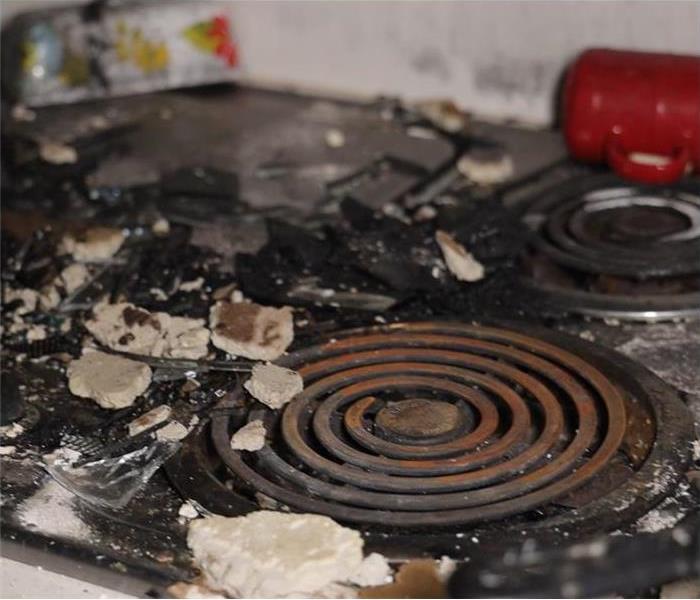 Cooking is the main cause for home fires and injuries.
Cooking is the main cause for home fires and injuries.
According to the National Fire Protection Association, cooking is the main cause for home fires and injuries, with Thanksgiving and Christmas being the peak days for cooking-related fires. Review the following safety tips to help ensure you enjoy a safe holiday.
- Do not wear loose clothing or dangling sleeves while cooking.
- Never leave cooking food unattended- stay in the kitchen when frying, grilling or broiling food. If someone must leave the kitchen for even a short period of time, they should turn off the stove.
- Check food regularly while cooking and remain in the home while cooking. Use a timer as a reminder that the stove or oven is on.
- Keep the kids away from the cooking area. Enforce a “kid-free zone” and make them stay at least three feet away from the stove.
- Keep anything flammable- pot holders, oven mitts, wooden utensils, paper or plastic bags, food packaging, and towels or curtains- away from the stove, oven or any other appliance in the kitchen that generates heat.
- Clean cooking surfaces on a regular basis to prevent grease buildup.
- Purchase a fire extinguisher to keep in the kitchen. Contact the local fire department to take training on the proper use of extinguishers.
- Always check the kitchen before going to bed or leaving the home to make sure all stoves, ovens, and small appliances are turned off.
- Install a smoke alarm near the kitchen, on each level of the home, near sleeping areas, and inside and outside bedrooms. Use the test button to check it each month. Replace all batteries at least once a year.
Tornado Damage and Your Home
11/20/2021 (Permalink)
 Tree uprooted by a tornado
Tree uprooted by a tornado
Tornadoes are a terrifying, often devastating, weather event.
They can turn houses into dust, and flip lives upside down. Living through a tornado can be traumatizing, and sometimes the aftermath is just as bad. Parts of your home may be destroyed, and the idea of fixing it can be overwhelming. Recovering from a tornado could be a huge task, depending on how bad the damage was. However, there are steps to take toward recovery and people ready to help along the way. There are steps that should be taken right after the storm passes, and other steps to take down the road when it is time for repairs and cleaning.
Protect Yourself and Your Loved Ones
The first step is to stay in your safe place until the storm has completely passed. If you are able, try and wait until you get the all clear from local officials. After the storm, check yourself and those with you for any injuries. If someone is hurt, the next step is seeking out first aid. After everyone has been checked and is okay, you should see how bad the damage to your house is. Make sure to watch out for anything that is unstable and likely to fall. If you go outside, look out for any downed power lines. They can be life threatening, so if you see downed power lines stay inside.
Protect Your Property
After you make sure yourself and your loved ones are protected, start protecting your property. You can make temporary repairs in order to prevent further damage. Many insurance companies will reimburse you for the cost, so make sure to keep receipts just in case. In addition to temporary repairs, living expenses may also be reimbursable. If your house is damaged to the point of you having to stay in a hotel, keep the receipts. Your policy may pay you back for the cost of it. Make sure to make a list of anything that was damaged, and don’t throw out damaged belongings. An adjuster will need to assess them for value if your policy covers replacing them. You should also inspect all utility lines and appliances. Any damage could lead to a gas leak or electric shortage. Damaged electric wires may also cause a fire. You may even have to turn off the main valve in order to prevent more harm to your house. Once these steps have been taken, contact your insurance company. From there, they can work with you to see what your policy covers. Most of the time, they will hire services to come out and repair damages.
Clean Up and Repair
SERVPRO of Durant has an incredibly fast response time when it comes to disasters. We have equipment and personnel ranging across 1,700 franchises. Our experience and training will allow us to restore your property quickly and efficiently. In addition, we will document the entire process.
The Need for an Emergency Plan
11/13/2021 (Permalink)
 Make sure you and your loved ones have a PLAN!
Make sure you and your loved ones have a PLAN!
In recent years, many different types of disasters have affected the United States.
Flooding, tornadoes, hurricanes, wildfires and blizzards are natural disasters that can threaten your home, business and community. Your local SERVPRO® Franchise Professionals want you and your customers to be aware of the steps to take to help prepare for Mother Nature's worst.
Right now is the perfect opportunity to review your emergency plan. Emergencies can happen unexpectedly in communities just like yours, to people just like you. Tornado outbreaks, river floods, flash floods, historic earthquakes, and even water main breaks and power outages in U.S. cities affecting millions of people for days at a time.
The more you know about what to do in an emergency, the more confident and secure you will feel in your abilities to manage through a disaster. Preparation is the key to making it through any size disaster, whether it is a small water leak, a large fire, or an area flood. The best time to plan for such events is not when the event happens, but well before it happens. No one ever plans on a disaster, but now, you can plan for it. Contact your local SERVPRO of Durant for more information and tools to help you be "Ready for whatever happens."
IICRC Certified Firm
11/6/2021 (Permalink)
 We are an IICRC Certified Firm
We are an IICRC Certified Firm
SERVPRO of Durant is an IICRC firm. The Institute of Inspection, Cleaning and Restoration Certification (IICRC) creates the standards for the restoration industry and provides training and certification to restoration companies.
IICRC Certified Firms must
• Present accurate information to consumers and conduct business with honesty and integrity.
• Require a technician on all jobs who has been formally trained and passed all required tests.
• Require a continuing education program to keep technicians up-to-date on the latest changes in the industry.
• Maintain liability insurance to protect all parties in the event of an accident.
• Maintain a written complaint policy and agree to Better Business Bureau or similar arbitration to resolve disputes, and accept the conclusions and recommendations of arbitration.
The IICRC Develops The Standards For The Restoration Industry
The IICRC has been the driving force in establishing the main industry standards and reference guides for professional carpet cleaning, water damage restoration and mold remediation. These IICRC standards take years to develop and require the coordination of experts in the field: manufacturers, industry organizations, insurance professionals, training schools, contractors, and public health professionals.
Every five years, the standards are reviewed and updated. The water damage restoration field changes rapidly with advancements in technology and science, and therefore the standards must evolve to keep pace.
About SERVPRO of Durant
SERVPRO of Durant specializes in the cleanup and restoration of residential and commercial property after a fire, smoke or water damage event. Our staff is highly trained in property damage restoration and we are an IICRC Certified Firm. We believe in continuous training: from initial and ongoing training at SERVPRO’s corporate training facility to regular IICRC-industry certification, rest assured our staff is equipped with the knowledge to restore your property.
Meet Our Crew
Circumstances for a Flood Cut
10/30/2021 (Permalink)
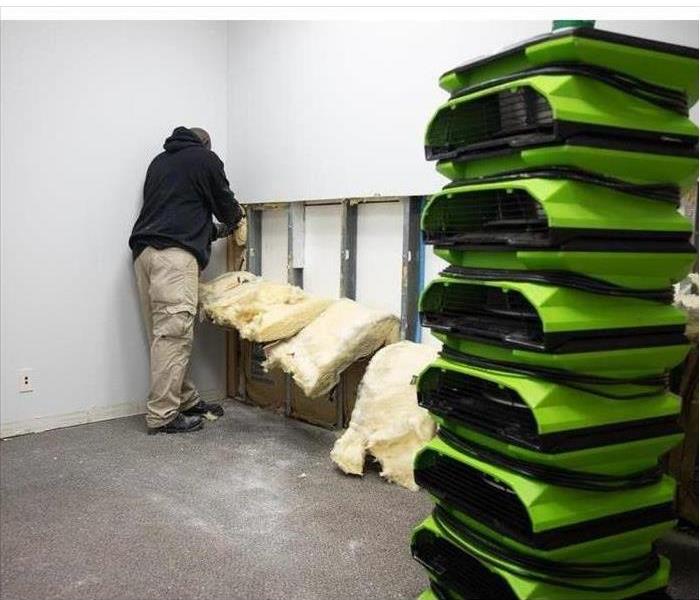 A flood cut can prevent this and keep mold at bay.
A flood cut can prevent this and keep mold at bay.
When flooding affects your home our technicians may perform a technique called a "flood cut".
This specific technique requires cutting out sections of drywall about a foot above the flood line to inspect the wall behind it. While this process is not always necessary, there are a few circumstances that may require it after a flood occurs.
- Black Water Floods
When outdoor flooding invades your home from overflowing streams or rivers, it may contain sewage, chemicals or dead animal carcasses. This water can be considered contaminated and is known as black water. A flood cut is usually necessary when this type of flooding occurs because your home’s drywall and any insulation behind it may be affected by the dirty water and may need replacing.
- Wet Insulation
Flood technicians may perform a flood cut and tear out sections of drywall if they believe any insulation behind your home’s walls has water damage. Because insulation cannot be properly dried, a flood cut may be needed to remove any wet material. Once the interior wall is cleaned and dried, new insulation can be installed.
- Mold Growth
After flooding, mold can begin to grow behind interior walls and spread quickly if it is not addressed. Flood technicians may perform a flood cut to check for mold and treat the area if any is found. Because mold does not need sunlight to grow, it can spread from interior walls to other areas and cause an unpleasant odor in your home. A flood cut can prevent this and keep mold at bay.
Flood Facts
10/23/2021 (Permalink)
 Stay away from floodwaters - Turn around don't drown
Stay away from floodwaters - Turn around don't drown
Floods are one of the most common and widespread natural disasters in the United States.
There is always potential for flood damage no matter where you live. According to the American Red Cross floods cause more damage in the United States every year than any other weather related disaster. The American Red Cross offers these flood safety tips:
- Stay away from floodwaters. If you come up on a flowing stream where water is above your ankles, stop, turn around and go another way. Six inches of swiftly moving water can sweep you off of your feet.
- If you approach a flooded road while driving, turn around and go another way. If you are caught on a flooded road and waters are riding rapidly around you, get out of the car quickly and move to higher ground. Most cars can be swept away by less than two feet of moving water.
- Keep children out of the water. They are curious and often lack judgment about running water or contaminated water.
If a flood occurs and affects you, call SERVPRO of Durant at (580) 740-4848. Even minor floods have potential to cause major damage. We are faster to ANY size disaster. Let us help you get your life back in order.
If a Disaster Strikes, Will You Be Ready?
10/16/2021 (Permalink)
 Sign up for local alerts and warnings
Sign up for local alerts and warnings
It is important to prepare before a storm or disaster occurs. Consider the following steps to better prepare for an emergency situation:
- Sign up for local alerts and warnings, download apps, and/or check access for wireless emergency alerts.
- Develop and test emergency communication plans with your family.
- Assemble or update your emergency supplies.
- Learn about local hazards in our city, and conduct drills to practice emergency response actions.
- Participate in a preparedness discussion, training, or class.
- Collect and safeguard critical documents.
- Plan with neighbors to help each other and share resources.
- Document property and obtain appropriate insurance for relevant hazards.
- Make property improvements to reduce potential injury and property damage.
Emergencies and storms can happen anytime to anyone. Taking action now helps to protect not only yourself, but also your property.
SERVPRO is not just a local brand, but a national one
10/2/2021 (Permalink)
 Call SERVPRO to make it "Like it never even happened."
Call SERVPRO to make it "Like it never even happened."
Since its founding in 1967 SERVPRO has expanded to over 1,700 locations across the United States and Canada. Since then SERVPRO has also greatly expanded the array of services we offer. Since those services range from carpet cleaning and deodorization to large scale disaster recovery and with SERVPRO’s 1,700+ locations our collective knowledge and experience are one of the greatest assets SERVPRO has and we know how to use it. SERVPRO locations provide all kinds of support to each other ranging from equipment to people-power and technical advice. Sometimes we might run into an issue that we have not encountered before or possibly elements to a job that prevents our normal methods for jobs. This is when we have been able to rely on the knowledge base which our corporate office and other SERVPRO’s have accumulated. It does not matter what emergency you are facing. From Water Mitigation, Fire Restoration, or Mold Remediation. SERVPRO has the team and backing to handle it all. We are known for taking care of big problems and disasters, but we also are adept at helping people with issues you normally may not know the solution too. If you have an emergency which makes you think “I don’t even know who does this,” try giving us a call.
We are SERVPRO of Durant
9/25/2021 (Permalink)
 SERVPRO of Paris Staff Cleaning up after winter storm.
SERVPRO of Paris Staff Cleaning up after winter storm.
SERVPRO of Durant specializes in the cleanup and restoration of residential and commercial property after a fire, smoke or water damage event.
Our staff is highly trained in property damage restoration and we are an IICRC Certified Firm. We believe in continuous training: from initial and ongoing training at SERVPRO’s corporate training facility to regular IICRC-industry certification, rest assured our staff is equipped with the knowledge to restore your property.
We will provide you with the support and service you need in any situation. We are always here to help.We pride ourselves on showing our customers how much we care. When you can make your customers happy and confident in what you do, you can be assured that they will always put their trust in you with any job. Call SERVPRO of Durant for all of your home needs.
The Potential Causes for Electrical Fires
9/18/2021 (Permalink)
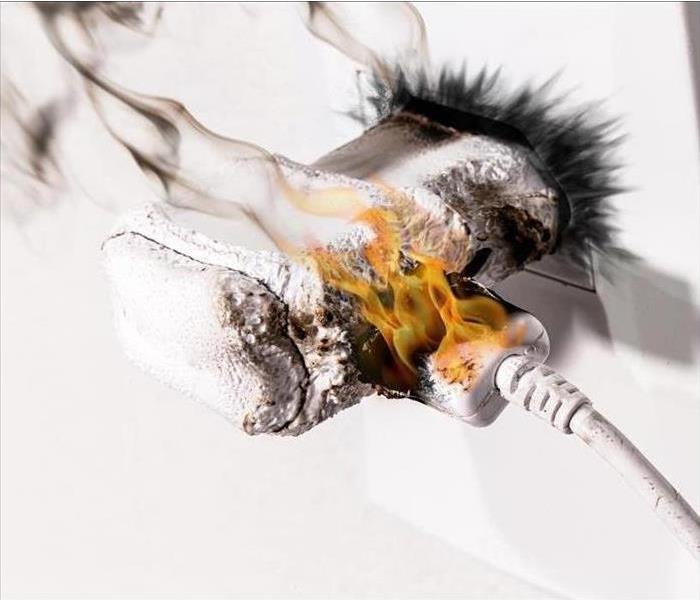 Most electrical fires are caused by faulty electrical outlets and or old, outdated appliances.
Most electrical fires are caused by faulty electrical outlets and or old, outdated appliances.
Most electrical fires are caused by faulty electrical outlets and or old, outdated appliances. The following are the most common reasons why electrical fires happen:
- Old electrical sockets and unsafe appliances
Appliances that are old and overused and those that fall short of modern safety standards are the worst culprits. Frayed electrical cords, self-jointed wires, and worn out sockets that are not properly grounded are major causes of fires. They become ready outlets for directing heat and fire to carpets, rugs, curtains and combustible plastic. Older appliances draw more power than the wall sockets can handle.
- Using light fixtures that exceed the permissible wattage
A very common cause of fires is plugging lights, lighting appliances and bulbs into electrical sockets that cannot handle higher wattage levels. Antique lighting appliances may have defective wiring that makes the appliance unstable by overheating. Decorating lights with colored paper and cloth shades can increase the risk of fire when the material or fabric heats up.
- Using multiple appliances plugged into an extension cord
Unrestricted use of extension cords is a major fire hazard. The risk of fire increases when your TV, home theatre, computer and other appliances are all plugged into a single extension cord. This creates excessive power load on a single socket which may not be designed to handle that load. So, there is a social and economic cost to damaged wiring!
- Locating portable heaters near combustible materials
Portable space heaters that use coils are potentially dangerous when they are positioned carelessly near curtains and rugs and adjacent to beds and cloth covered furniture. The chances of inflammable material coming into contact with the red-hot coils increase the risk of fire.
- Wiring that becomes defective with the passage of time
Over a period of time you add more electrical appliances such as wide screen televisions, home theatre, microwave oven, refrigerator and air conditioners. The outdated home wiring cannot handle the increased power load. Older wiring tends to heat up quickly and catches fire. If the breaker boxes are themselves defective, they cannot prevent overheated electrical panels from catching fire.
Why Should I Call Professionals for Water Cleanup and Restoration?
9/18/2021 (Permalink)
 After your home suffers water damage, you need a team of professionals to assist you with cleanup. Call SERVPRO of Paris right away!
After your home suffers water damage, you need a team of professionals to assist you with cleanup. Call SERVPRO of Paris right away!
SERVPRO of Durant Offers 24/7 Emergency Services to Handle Your Water Damage and Restoration Needs
A sudden water intrusion like a leaking pipe or the breakdown of your water heater can be a sizable inconvenience. However, this inconvenience turns into a substantial loss if not addressed quickly and using the right methods. Hiring trained water restoration technicians (WRT) to come to your home helps you limit the loss and get your home back to normal faster than DIY methods alone.
What is SERVPRO’s Response Plan for Water Damage?
Whenever we get called for water damage restoration we formulate a plan based on any combination of methods to help us:
- Minimize the need for demolition
- Repair or restore rather than replace
- Create an optimum atmosphere for drying, such as closed drying systems
- Expedite restoration to have you back to your routine fast
How is the Need for Demolition Determined?
With many water removal project demolition is required to remove any wet structural components or wall materials. Controlled or partial demolition efforts allow us to remove and replace just a portion of the materials to have it finished off to match the preloss condition. Our team always uses a variety of non-invasive techniques to ensure no moisture is left behind, including:
- Moisture sensors
- Moisture detectors
- Thermal cameras
Of course, whenever your interior has standing water, we use extraction tools and a combination of methods to facilitate faster removal. Some of the standard options our SERVPRO technicians will use include:
- Submersible pumps
- High-powered extractors
- Draining any trapped water behind walls using bore-holes
- Mopping
- Wet-Vac, and more
Why Should I Have SERVPRO of Durant Restore My Carpets?
We are well-versed in best practices for restoring carpeting impacted by water loss within the home. Upon arrival and formulation of our restoration plan, we inspect your carpeting and select the best equipment and methods to achieve our goals. The process includes:
- Inspecting carpeting using moisture probe technology – this allows us to determine how deep the moisture has embedded into the carpet and the pad below.
- Detachment of the carpet with the proper tools so our technicians can further inspect to see if the carpet has delaminated or mold has begun to colonize.
- In cases where the water has not infiltrated the carpet pad or the subfloor below, we may use centrifugal air movers to float the carpet, thus allowing warm air to circulate beneath.
- In cases where water moisture saturates the carpet fully, we will remove the padding below and dispose of it to be replaced after the drying of the zone is complete.
In general, carpet detachment is the fastest way to facilitate drying as it allows air to flow underneath. However, we have some in-place drying methods that will enable us to achieve drying goals without detachment. This may involve using a weighted extractor, or rover, that works from the perimeter inward while drying. In-place drying is ideal when moisture has not made it all the way down to the carpet padding.
Why is Professional Restoration Better Than DIY?
What many homeowners may not realize is that there does not have to be extensive water damage for it to add up to an immense loss. There could be hidden moisture left behind in wall cavities and other tight spots that make it difficult for DIY methods to get the job done. SERVPRO features IICRC-certified technicians that have the choice between two distinct systems to ensure your home is back to appropriate humidity levels. These systems include:
- Open Drying System – This works by using outside air to speed up the drying of the impacted area. Warmer months allow us to use an open system for active, time-efficient drying. This method helps to promote evaporation while using equipment like air-movers and box fans to exchange evaporated moisture with drier outside air. We can do this by opening up doors and windows in conjunction with a centrifugal motion to create fluid air movement.
• Closed Drying System – This system works by using dehumidification equipment within a concentrated drying zone for air exchange. Such a method is excellent during times of the year when temperatures are lower, and access to the outdoors is limited. This works on the same principle, yet a closed system gives more control of the temperatures. Higher temps mean the air holds more moisture, and drying is faster. We also use desiccant dehumidifiers within the work zone for moisture removal and to thwart the potential for mold growth.

 24/7 Emergency Service
24/7 Emergency Service



















